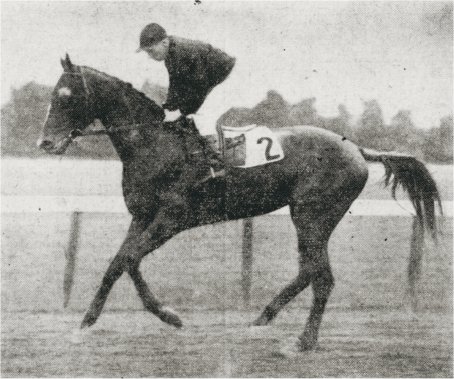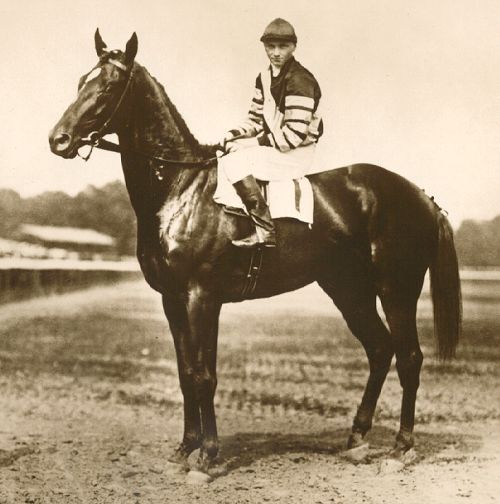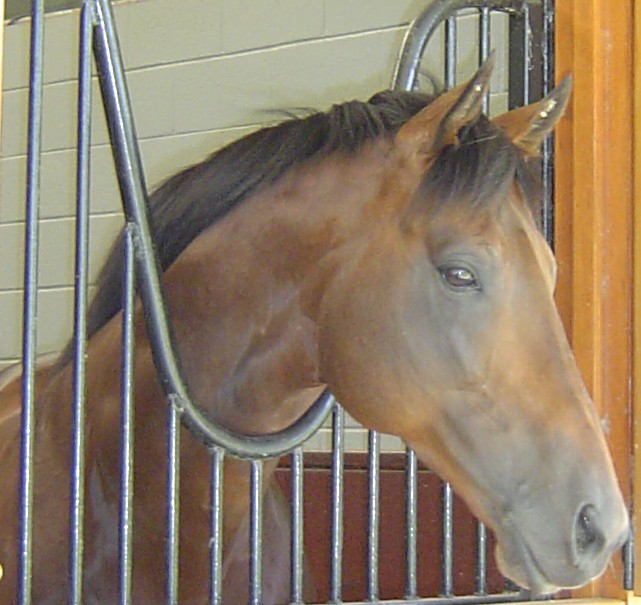|
Chance Play
Chance Play (foaled 1923) was an American Champion Thoroughbred racehorse and Champion sire. In a career which lasted from 1925 to 1928 he ran in thirty-nine races and won sixteen of them. Although he was successful in his early career over sprint distances, he did not reach his peak until the age of four in 1927, when he was arguably the best horse in the United States, winning several major races including the two-mile Jockey Club Gold Cup. Background Bred by August Belmont Jr., he was out of the mare Quelle Chance, a daughter of 1900 Metropolitan Handicap winner, Ethelbert. He was sired by Fair Play who also sired Man o' War. Chance Play was as well a full brother to 1927 Belmont Stakes winner, Chance Shot. In 1923, New York city financiers W. Averell Harriman and Bert Walker bought a stable of Thoroughbred horses which they raced under the ''nom de course'' Log Cabin Stable, sporting orange and white silks. As part of a private purchase of twenty horses, in January 19 ... [...More Info...] [...Related Items...] OR: [Wikipedia] [Google] [Baidu] |
Fair Play (horse)
Fair Play (April 1, 1905 – December 17, 1929) was an American-bred Thoroughbred racehorse who was successful on the track, but even more so when retired to stud. He is best known as the sire of Man o' War, widely considered one of the greatest American racehorses of all time. On the racetrack, Fair Play was known for his rivalry with the undefeated Colin, to whom he finished second in the Belmont Stakes. Later, Fair Play was the leading sire in North America of 1920, 1924 and 1927, and the leading broodmare sire of 1931, 1934 and 1938. He was inducted into the National Museum of Racing and Hall of Fame in 1956. Background Fair Play raced as a homebred for August Belmont Jr., who was chairman of The Jockey Club from 1895 until his death in 1924. Belmont became involved in horse racing through his father, in whose honor the Belmont Stakes was named. Belmont purchased a two-year-old colt named Hastings in 1895, who went on to win the Belmont Stakes the following year. Hastings ... [...More Info...] [...Related Items...] OR: [Wikipedia] [Google] [Baidu] |
Havre De Grace Handicap
The Havre de Grace Handicap was an American Thoroughbred horse race first run on the August 26, 1912 opening day of the new Havre de Grace Racetrack in Havre de Grace, Maryland. Although most of its runnings would take place in early fall, its final edition was run there on April 30, 1949. Due to Federal government wartime regulations, the 1943 edition was held at Laurel Park and in 1945 at Pimlico Race Course. A race for horses age three old or older, it was run on dirt over a distance of 1 1/8 miles with the exception of 1918 when it was set at 1 mile and 70 yards. From inception through 1939, the race was known as the Havre de Grace Cup Handicap. Historical notes The 38 runnings of the Havre de Grace Handicap produced a number of wins by racing's top horses. The 1915 edition saw ''Life'' magazine co-founder Andrew Miller win with his future U.S. Racing Hall of Fame inductee, Roamer. The 1916 winner, The Finn, had won the 1915 Belmont Stakes and earned American Champion Thr ... [...More Info...] [...Related Items...] OR: [Wikipedia] [Google] [Baidu] |
Belmont Stakes
The Belmont Stakes is an American Grade I stakes race for three-year-old Thoroughbreds run at Belmont Park in Elmont, New York. It is run over 1.5 miles (2,400 m). Colts and geldings carry a weight of ; fillies carry . The race, nicknamed The Test of the Champion, The Test of Champions and The Run for the Carnations, is the traditional third and final leg of the Triple Crown. It is usually held on the first or second Saturday in June, five weeks after the Kentucky Derby and three weeks after the Preakness Stakes. The 1973 Belmont Stakes and Triple Crown winner Secretariat holds the track record (which is also a world record on dirt) of 2:24. The race covers one full lap of Belmont Park, known as "The Championship Track" because nearly every major American champion in racing history has competed on the racetrack. Belmont Park, with its large, wide, sweeping turns and long homestretch, is considered one of the fairest racetracks in America. Despite the distance, the race t ... [...More Info...] [...Related Items...] OR: [Wikipedia] [Google] [Baidu] |
Man O' War
Man o' War (March 29, 1917 – November 1, 1947) was an American Thoroughbred racehorse who is widely regarded as the greatest racehorse of all time. Several sports publications, including ''The Blood-Horse'', ''Sports Illustrated'', ESPN, and the Associated Press, voted Man o' War as the best American racehorse of the 20th century. During his racing career, just after World War I, Man o' War won 20 of 21 races and $249,465 () in purses. He was the unofficial 1920 American horse of the year and was honored with Babe Ruth as the outstanding athlete of the year by ''The New York Times''. He was inducted into the National Museum of Racing and Hall of Fame in 1957. On March 29, 2017, the museum opened a special exhibit in his honor, "Man o' War at 100". In 1919, Man o' War won 9 of 10 starts, including the Hopeful Stakes and Belmont Futurity, then the most important races for two-year-old horses in the United States. His only loss came at Saratoga Race Course, later nicknamed the Gr ... [...More Info...] [...Related Items...] OR: [Wikipedia] [Google] [Baidu] |
Metropolitan Handicap
The Metropolitan Handicap, frequently called the "Met Mile", is an American Grade I Thoroughbred horse race held at Belmont Park in Elmont, New York. Open to horses age three and older, it is contested on dirt over a distance of one mile (8 furlongs). Starting in 2014, it is now run on the same day as the Belmont Stakes in early June. The Met Mile is one of the most prestigious American races outside of the Triple Crown and Breeders' Cup. It is known as a "stallion-making race" as the distance of a mile often displays the winner's "brilliance", referring to an exceptional turn of foot. Winners of the race who went on to become notable stallions include Tom Fool (1953), Native Dancer (1954), Buckpasser (1967), Fappiano (1981), Gulch (1987–88), and Ghostzapper (2005). History The Met Mile was first run in 1891 at Morris Park Racetrack. Prior to 1897, it was run at a distance of miles. In 1904, its location was moved to Belmont Park. There it remained except for nine ye ... [...More Info...] [...Related Items...] OR: [Wikipedia] [Google] [Baidu] |
United States
The United States of America (U.S.A. or USA), commonly known as the United States (U.S. or US) or America, is a country primarily located in North America. It consists of 50 U.S. state, states, a Washington, D.C., federal district, five major unincorporated territories, nine United States Minor Outlying Islands, Minor Outlying Islands, and 326 Indian reservations. The United States is also in Compact of Free Association, free association with three Oceania, Pacific Island Sovereign state, sovereign states: the Federated States of Micronesia, the Marshall Islands, and the Palau, Republic of Palau. It is the world's List of countries and dependencies by area, third-largest country by both land and total area. It shares land borders Canada–United States border, with Canada to its north and Mexico–United States border, with Mexico to its south and has maritime borders with the Bahamas, Cuba, Russia, and other nations. With a population of over 333 million, it is the List of ... [...More Info...] [...Related Items...] OR: [Wikipedia] [Google] [Baidu] |
Sire
Sire is an archaic respectful form of address to reigning kings in Europe. In French and other languages it is less archaic and relatively more current. In Belgium, the king is addressed as "Sire..." in both Dutch and French. The words "sire" and " sir", as well as the French " (mon)sieur" and the Spanish " señor", share a common etymological origin, all ultimately being related to the Latin ''senior''. The female equivalent form of address is dame or dam. See also * Forms of address in the United Kingdom * King * Nobility Nobility is a social class found in many societies that have an aristocracy (class), aristocracy. It is normally ranked immediately below Royal family, royalty. Nobility has often been an Estates of the realm, estate of the realm with many e ... References {{Social titles Men's social titles Nobility Royal styles ... [...More Info...] [...Related Items...] OR: [Wikipedia] [Google] [Baidu] |
Horse Racing
Horse racing is an equestrian performance sport, typically involving two or more horses ridden by jockeys (or sometimes driven without riders) over a set distance for competition. It is one of the most ancient of all sports, as its basic premise – to identify which of two or more horses is the fastest over a set course or distance – has been mostly unchanged since at least classical antiquity. Horse races vary widely in format, and many countries have developed their own particular traditions around the sport. Variations include restricting races to particular breeds, running over obstacles, running over different distances, running on different track surfaces, and running in different gaits. In some races, horses are assigned different weights to carry to reflect differences in ability, a process known as handicapping. While horses are sometimes raced purely for sport, a major part of horse racing's interest and economic importance is in the gambling associated w ... [...More Info...] [...Related Items...] OR: [Wikipedia] [Google] [Baidu] |
Thoroughbred
The Thoroughbred is a horse breed best known for its use in horse racing. Although the word ''thoroughbred'' is sometimes used to refer to any breed of purebred horse, it technically refers only to the Thoroughbred breed. Thoroughbreds are considered " hot-blooded" horses that are known for their agility, speed, and spirit. The Thoroughbred, as it is known today, was developed in 17th- and 18th-century England, when native mares were crossbred with imported Oriental stallions of Arabian, Barb, and Turkoman breeding. All modern Thoroughbreds can trace their pedigrees to three stallions originally imported into England in the 17th and 18th centuries, and to a larger number of foundation mares of mostly English breeding. During the 18th and 19th centuries, the Thoroughbred breed spread throughout the world; they were imported into North America starting in 1730 and into Australia, Europe, Japan and South America during the 19th century. Millions of Thoroughbreds exist tod ... [...More Info...] [...Related Items...] OR: [Wikipedia] [Google] [Baidu] |
Chicago Motor Speedway
The Chicago Motor Speedway at Sportsman's Park was a motorsports race track, located in Cicero, Illinois, just outside Chicago. It was built in 1999 by a group including Chip Ganassi, owner of Chip Ganassi Racing. In 2002 the oval shaped track suspended operations due to financial conditions in the motorsports industry. The track was also the site of horse races, for which the track was called "Sportsman's Park". The track was one of two racetracks that hosted both NASCAR auto races and horse races (the other is Dover International Speedway). History Before 1999, Sportsman's Park was one of the premier locations for horse racing in the area. Hawthorne Race Course, located right across the street to the south from the track, is the current host of the Illinois Derby. The two tracks operated together for decades. In 1999, after the final season of the old Sportsman's Park, the main grandstand and infield were completely demolished to make way for the massive grandstand that ... [...More Info...] [...Related Items...] OR: [Wikipedia] [Google] [Baidu] |
Leading Sire In North America
The list below shows the leading sire of Thoroughbred racehorses in North America for each year since 1830. This is determined by the amount of prize money won by the sire's progeny during the year. It is restricted to stallions which are based in North America, but currently includes earnings from overseas races in Great Britain, Ireland, France, Italy, Germany and the United Arab Emirates as well as domestic earnings. Prior to 2015, the Leading Sire Lists published by The Blood-Horse excluded earnings from Hong Kong and Japan due to the disparity in purses. Starting in 2015, earnings from Hong Kong and Japan are included on an adjusted basis. List * 1830: Sir Charles (1) * 1831: Sir Charles (2) * 1832: Sir Charles (3) * 1833: Sir Charles (4) * 1834: Monsieur Tonson (1) * 1835: Bertrand (1) * 1836: Sir Charles (5) * 1837: Leviathan (1) * 1838: Leviathan (2) * 1839: Leviathan (3) * 1840: Medoc (1) * 1841: Medoc (2) * 1842: Priam (1) * 1843: Leviathan (4) * 1844: Priam ... [...More Info...] [...Related Items...] OR: [Wikipedia] [Google] [Baidu] |
American Champion Older Male Horse
The title of American Champion Older Dirt Male Horse is an American Thoroughbred horse racing honor awarded annually to a stallion or gelding, four years old and up, for performances on dirt and main track racing surfaces. In 1971, it became part of the Eclipse Awards program as the award for Champion Older Male Horse. The award originated in 1936 when the ''Daily Racing Form'' (DRF) began naming an annual champion. In the same year, the Baltimore-based ''Turf and Sports Digest'' magazine instituted a similar award. Starting in 1950, the Thoroughbred Racing Associations (TRA) began naming its own champion. The following list provides the name of the horses chosen by these organizations. Whenever there were different champions named, the horses are listed side-by-side with the one chosen as champion by the ''Daily Racing Form'' noted with the letters (DRF), the one chosen by the Thoroughbred Racing Associations by the letters (TRA) and the one chosen by ''Turf and Sports Digest'' by ... [...More Info...] [...Related Items...] OR: [Wikipedia] [Google] [Baidu] |



